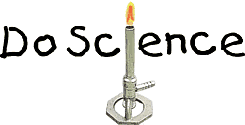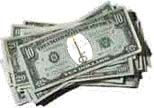![]()

|
The Archive List |
|
Do you have a comment or response to this activity, submit it to the Do Science bulletin board. |
![]()

Counterfeit currency often makes big headlines in the newspaper --- counterfeiting rings are broken up, counterfeit money is discovered being "passed" at the local bank or grocery store. How can the "experts" tell the difference between real and fake? Use some science and some sleuthing to learn how!
Materials
- Magnifying glass
- One dollar bill
- One five-dollar bill printed since 1990 (see front of bill to lower right of portrait)
- One "fake" five-dollar bill (front only). Make the "fake by using a copying machine (it's legal to make the "fakes" as long as they're for classroom educational purposes). Copy the front of the bill (color copying is best, but black and white will work) and cut it out. Destroy the copy as soon as you are done with the activity.
The Scene of the Crime
Here's a scenario: Imagine that you're a brand new Secret Service agent and your first assignment is to examine a pile of money confiscated during a raid and determine if it is real or counterfeit. How would you approach this problem? You know that the Treasury Department of the Federal government is responsible for printing currency, and that they have many "secret" anti-counterfeiting features incorporated into currency. You realize that you can use a magnifying glass to discover some of these "secrets" and succeed in your important (but fictional) assignment.
1. Run your fingertip along the empty part of the dollar bill and compare the feel to that of the highly doodled area by the "1" in the corner. Do they feel the same or different? What color are the clear areas of the bill?
2. With the magnifying glass, examine the clear areas of the $1 bill. Move the bill around. What color does it look like? What else do you see in the clear area?
3. Compare the front of the real and fake five-dollar bills with your eyes alone. Can you tell which is which? How? Examine the lines around Lincoln's face and eyes with the microscope. Now compare that to the same area of the "fake" bill -- is there a difference?
4. Look in the clear area to the left of the Federal Reserve Seal (which is to the left of Lincoln's portrait). What do you see ? Can you make out any writing?. Look for this on the "fake" bill -- is it there?
5. Without using the magnifier, examine the rim around Lincoln's portrait. Is it a solid line? Now use the magnifier. Do you see anything different? Check your "fake" bill for this feature.
6. What other features do you see that can distinguish authentic bills from "fakes"?
WHAT'S REAL AND WHAT'S NOT
CONGRATULATIONS!!! You've successfully completed your first Secret Agent assignment! During your analysis, you will have observed a number of anti-counterfeiting devices in the currency. On any U.S. currency bills, some of these include the crispness of the printed lines; the use of a special paper used only for currency, which has a very different feel and longevity than any other paper; the inclusion of a few red and blue fibers in the paper (only three pounds of red and blue fibers are added for every ten thousand pounds of untinted fibers used). You can feel the raised ink on the genuine bill, but this will not be present on a counterfeit bill. Lettering around portraits on the bills appears as solid lines to the naked eye, but spells out words with letters only seven thousandths of an inch high.
On a five dollar bill, the lines around Lincoln's eyes differ on the real and the "fake" - the lines are much crisper on authentic bill. To the left of the Federal Reserve Seal on the $5 bill is a clear polyester thread with writing on it, stating USA Five, repeated five times. Other, higher denominations have similar threads in them.
REALLY?!!!
Our nation adopted a national currency in 1863, and since that time the United States Treasury Department has been printing our folding money. "Fake" bill have been around since the very beginning, and since that time the government has devised ways of printing that help to thwart counterfeiters. Today, with computer technology, the challenge is greater, but there are still many aspects of the money that's hard to duplicate.
Copyright KK 2000.